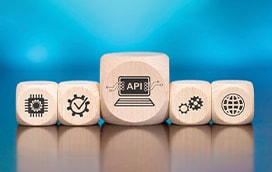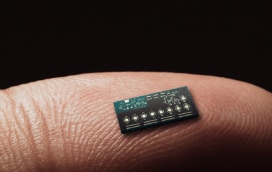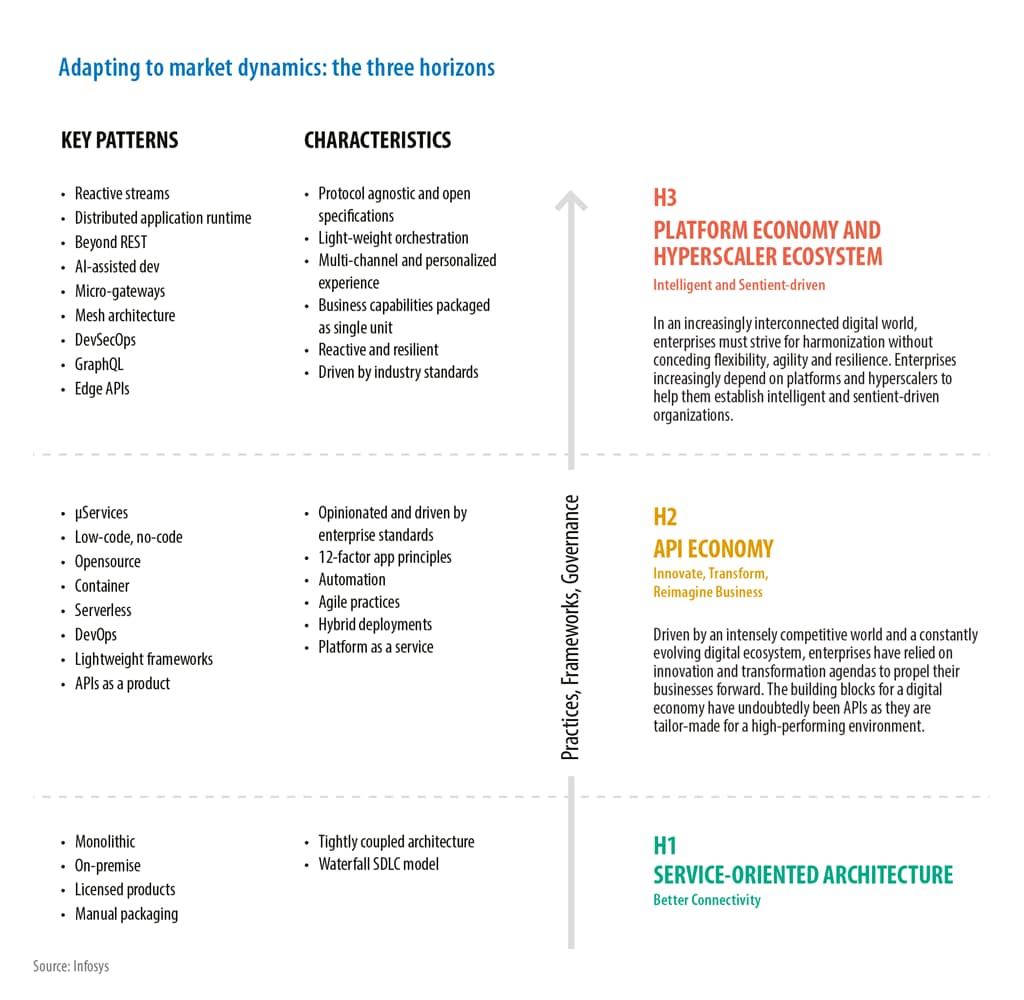API, Microservices
Enterprises progressively shift to cloud and hybrid ecosystems to accelerate their digital journey. API-led transformation helps expand businesses, modernize core functions, and enhance customer experience.
Hyperscaler ecosystem, connected marketplaces, and platform economy
H3
PLATFORM ECONOMY AND HYPERSCALER ECOSYSTEM
Intelligent and Sentient-driven
Key Patterns
- Reactive streams
- Distributed application runtime
- Beyond REST
- AI-assisted dev
- Micro-gateways
- Mesh architecture
- DevSecOps
- GraphQL
- Edge APIs
Characteristics
- Protocol agnostic and open specifications
- Light-weight orchestration
- Multi-channel and personalized experience
- Business capabilities packaged as single unit
- Reactive and resilient
- Driven by industry standards
H2
API ECONOMY
Innovate, Transform, Reimagine Business
Key Patterns
- μServices
- Low-code, no-code
- Opensource
- Container
- Serverless
- DevOps
- Lightweight frameworks
- APIs as a product
Characteristics
- Opinionated and driven by enterprise standards
- 12-factor app principles
- Automation
- Agile practices
- Hybrid deployments
- Platform as a service
H1
SERVICE-ORIENTED ARCHITECTURE
Better Connectivity
Key Patterns
- Monolithic
- On-premise
- Licensed products
- Manual packaging
Characteristics
- Tightly coupled architecture
- Waterfall SDLC model
Key trends across API subdomains
Trend 1
Adoption of CNCF standards increases
The microservices architecture helped achieve on-demand elasticity and scalability of APIs for both on-premises and public hyperscaler infrastructure. APIs and microservices had to deploy hybrid infrastructure in addition to serverless infrastructure to support evolving requirements.
Trend 2
New application layer protocols replace HTTP REST for greater efficiency
Hyperscaler adoption has enhanced focus on security, performance, lightweight containers, and availability. The APIs and microservices should support the hybrid user interface/user experience ecosystem in addition to serverless solutions. This has brought a new requirement to look beyond TCP/IP, HTTP protocols.
Trend 3
Go and Kotlin become the primary choice for lightweight microservices
Go offers high runtime efficiency with strong memory safety, garbage collection, and structural typing. It is already a top choice for system design and is widely used for microservices. Infosys uses Go for projects with critical memory footprint.
Trend 4
.NET 5 improves developer experience and unifies runtime behavior on multiple platforms
The release of .NET unified ASP.NET, .NET Core, Entity Framework Core, WinForms, Windows Presentation Foundation, Xamarin, and ML.NET and provide a single platform to build cross-platform applications.
Trend 5
Focus shifts from languages and frameworks to stacks
With the evolving microservices landscape, more frameworks, messaging systems, transport layers, data serialization formats, APIs, etc., will emerge. Since these components constitute a whole stack of offerings, developers are less likely to choose individual languages and frameworks for their application development.
Trend 6
Polyglot frameworks gain prominence
Modern Java frameworks that offer fast throughput and nominal startup time (e.g., Quarkus, Micronaut, and Helidon) have become instrumental in robust microservice and serverless application builds. These frameworks support Amazon Web Services (AWS) Lambda, and Azure Functions, as well as non-blocking reactive styles of programming and declarative types.
Trend 7
Browser-based IDE and cloud workspaces proliferate
In-browser IDEs help with mobility, portability, and better team-level collaboration. Efforts are underway to eliminate any system constraints. IDEs also possess AI-assisted intelliSense features that utilize the developer's current context and patterns based on thousands of highly rated open-source projects on GitHub. Thanks to increased cloud adoption, the browser-based IDEs such as Codespaces and Codenvy have gained traction.
Trend 8
Cloud engineering using DevSecOps becomes a norm
Agile methodology and microservices have triggered frequent builds and deployment. As a result, opensource components in the software and image containers deployed in Kubernetes clusters remain vulnerable. However, tools such as NeuVector make the “shift left” security to the build phase possible, and the scans occur at a faster pace.
Trend 9
Complete API-driven infrastructure proves efficient in handling multiple cloud platforms
In today's dynamic environment, API-driven infrastructure provides the ability to set up infrastructure in the cloud or on-premises with the use of programming languages and libraries. The adoption of Terraform and Ansible in the industry has fueled more APIs in the infrastructure as code.
Trend 10
Enterprises increasingly adopt API marketplace solutions
The API marketplace platform solutions enable enterprises to integrate a single governance framework for multi-API gateways, and accelerate development with prebuild standard and domain APIs to expedite digital transformation.
Trend 11
LCNC platforms accelerate API adoption
LCNC platforms help integrate and automate workflows with little or no programming knowledge. These platforms support a wide range of out-of-box integration capabilities and connectors that can be built and deployed through drag-drop code features and configurations. These platforms enable customers to accelerate their API and microservices journey, either on-cloud or on-premises.
What's New
Latest White Papers, Tech Blogs and View Points

Subscribe
To keep yourself updated on the latest technology and industry trends subscribe to the Infosys Knowledge Institute's publications
Count me in!


























